|
Introduction
The Saxon Cross Shaft, minus its
surmounting cross, in St. Peter’s Gardens (previously
churchyard) is the oldest relic of Wolverhampton’s early
history and the most ancient edifice in the West Midland
Conurbation, yet many Wulfrunians do not seem to be
aware of its existence. It has witnessed incredible
changes in the development of the town since it was
first raised on the highest point in the town centre, a
position it has occupied ever since. Probably one of the
most dramatic events to take place in its vicinity was
the rout of the Danish army in 910/911AD at the Battle
of Tettenhall, or was it Wednesfield or both? Our cross
might have heard the clamour of the battle possibly
safely protected by Heantun’s defensive palisade,
depending of course on its hotly disputed age. |
|

The Saxon column in St. Peter’s
Gardens. |
Much has been written about the
cross shaft, with a considerable amount available on
line but it could be said to have had mixed appraisals:
some writers on Saxon sculpture ignored it altogether
but T. D. Kendrick writing in 1938 called it ‘The
noblest monument of its kind that has come down to us’:
he regarded it as unique and the only surviving example
of the southern continental Baroque style from the ninth
century.
The most authoritative recent
accounts are those written by the late Mr. Michael M.
Rix staff tutor in architectural history at the
extra-mural department of Birmingham University, and
more recently a study by Professor Jane Hawkes of York
University. Michael Rix’s article was published by the
Royal Archaeological Institute in its journal of June
1962 and Jane Hawkes’ study is in the recently published
(2018) Corpus of Anglo-Saxon Stone Sculpture for
Derbyshire and Staffordshire. This article makes use of
information from both publications together with some
additional comments and observations. |
|
Historical
background
In the sixth and seventh centuries
peripatetic Celtic priests would establish preaching
locations and would carry with them their wooden staff
with its cross head, to plant on the ground whist they
addressed their listeners. Depending on their success a
fixed wooden cross would be erected on the preaching
site which in time would be replaced with a more
permanent stone cross. These crosses almost invariably
predated the foundation of a church on the same site and
the subsequent church would usually be built immediately
to the north of the cross to prevent the church’s shadow
from falling on the cross. The date of any wooden cross
in Wolverhampton will never be known, and the date of
its stone replacement is a matter of considerable
dispute. |
|
Michael Rix comments: - ‘The
Wolverhampton Cross deserves a distinguished place in
any catalogue of Anglo-Saxon art by virtue both of its
scale and the quality of its decoration. Its position is
also focal in any study of the fifty and more
cylindrical-shafted carved crosses of this period’.
The Wolverhampton cylindrical cross
shaft was for long a source of dispute among experts of
pre-Norman Conquest sculpture. Disagreements arose over
its original purpose and creation date: was it pagan or
Christian? Danish or Saxon? did it date from the late
12th.century or the mid-9th? The air has cleared over
the last 80 years and it is now known to be Saxon in
origin and created within an approximately 100-year time
frame. It deserves a distinguished place in any
catalogue of Anglo-Saxon art and is one of more than two
thousand or so cross shafts of the Saxon period around
Britain most of which exist only as fragments, it is the
only complete Saxon monolithic circular column remaining
in the country.
Despite being ignored by some
writers it was considered important enough to have a
plaster cast made from it in 1877 from a mould made by
Sergeant Bullen of the Royal Engineers. The cast was
placed in the Great Cast Hall of the Victoria and Albert
Museum where, ironically it was placed next to a cast of
Trajan’s Column from Rome, somewhat undermining its
grandeur. Unfortunately, the cast is now in storage
following reordering of the Cast Hall.
The casting of the Wolverhampton column proved to be
most fortuitous: whilst the real column has suffered
badly form pollution and weathering over the last 140
plus years, the cast obviously has not and was used in
1913 by Dorothy B. Martin as a source for an extended
drawing of its carved decoration. |

Plaster cast in the Victoria and
Albert Museum. |
|
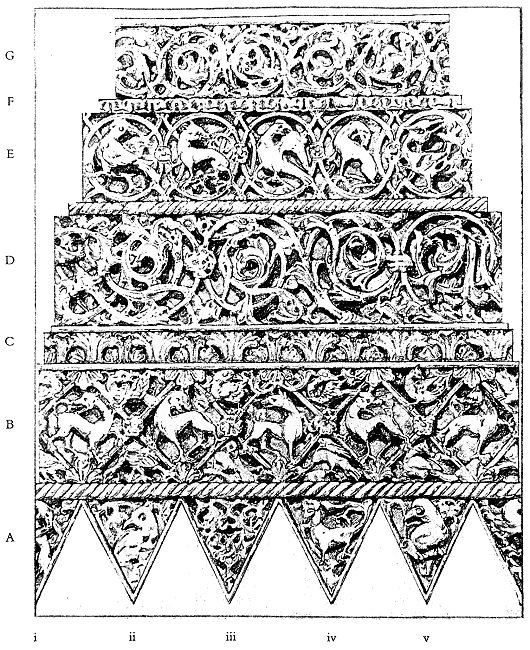
Extended drawing of ornament on
the column by Dorothy B. Martin. 1911. |
The column is approximately 4.3 metres (14 feet)
tall (its precise height is concealed by the more recent
supporting stones around its base) and varies in
diameter from 0.76 metres (30 inches) at the base to
0.56metres (22inches) at the top, immediately under the
cap. Early writers believed it to be of post Conquest
date but this view changed in the 1930s when a date of
994 was suggested, to coincide with the foundation,by
Lady Wulfruna, of St. Peter’s Church as a minster,
however this event is considered somewhat dubious by
Professor Hawkes in her recent study.
In 1938 T. D. Kendrick in his book ‘Anglo Saxon Art
to AD 900’ pushed the date back even further to the
middle of the ninth century, a date postulated by
Michael Rix in his paper, following extensive research.
|
|
That date has now been modified
again by Professor Hawkes who believes early to
mid-tenth century is a safer estimate. She tells us that
despite its long history there is no recorded mention of
it until 1794 when it was discussed in a letter to the
Gentleman’s Magazine, although it is shown on Isaac
Taylor’s map of Wolverhampton published in 1750.
The dating of the column is based
mainly upon the style of decoration carved around its
circumference, it comprises predominantly typical pre
Danish (Viking) era ornamentation, consisting of bands
of exuberant swirls of foliage between bands of frisky
Anglian beasts with their heads turned looking
backwards, all carved with supreme skill. More
importantly it has two bands of Acanthus leaf decoration
that provide the principal basis for its dating.
Artistic Inspiration
It was suggested in Mr. Rix’s
article that the designs of many Saxon cross shafts,
circular and rectangular, were based upon the wooden
staff rood of the early missionary that was planted as a
rallying point and for use as a preaching cross. This
suggestion arises partly from the pendant triangular
forms at the bottom of the decoration on some cross
shafts, including the Wolverhampton column, matching
those found on fragments of metalwork from early cross
staffs. The foliage and animal decoration are also a
common feature on both the metalwork attached to wooden
staffs and some stone crosses. The decoration on the
Wolverhampton column exhibits a degree of undercutting
matching the filigree metalwork popular in the ninth
century. This led Mr. Rix to suggest that this type of
metalwork was the direct artistic inspiration for the
carving on the column.
Some of the animals on the
Wolverhampton column are similar to those on items of
metalwork found in the Trewhiddle hoard, discovered in
Cornwall in 1774. Coins found in the hoard date these
items to the third quarter of the ninth century, so
leading Mr. Rix to propose a similar date (850 AD.) for
the carving on the Wolverhampton column but within a
fairly wide stylistic period.
Mr. Rix also identifies other
similar and well-known crosses and fragments of the same
period. Sir Nikolaus Pevsner relates the Wolverhampton
column to cross fragments at Masham and Dewsbury, both
in Yorkshire, grouping all three as Mercian types
because of their circular section, and dating them to
the early 9th century.
Professor Hawkes, as mentioned
above, believes the column relates more to the
Benedictine Reform period in the middle of the 10th
century. The date range of 850 to 950 AD is determined
predominantly by the use of Acanthus leaf decoration as
discussed below.
|
|
The Acanthus Factor
One of the more interesting
features of the ornament and possibly unique to the
Wolverhampton column are two narrow bands of Acanthus
leaf decoration and Acanthus leaves attached to the
exuberant grape vine scroll in the wider bands, an
artist’s botanical hybrid! ? |
|
|
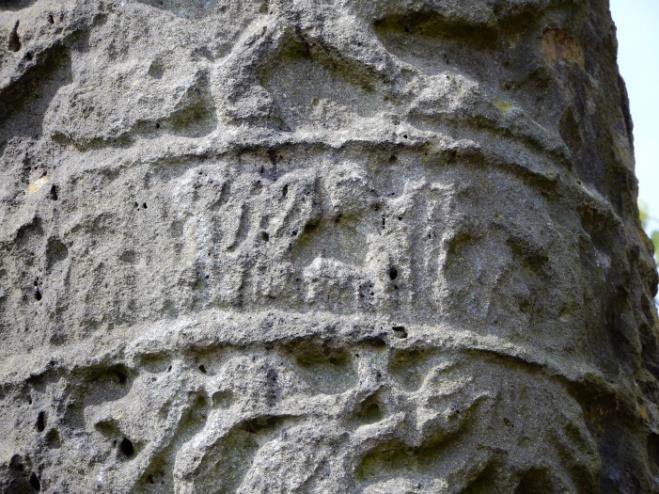
Band of Acanthus Leaf
decoration. |
| It is the use of Acanthus foliage that provides
the clue to the age of the column, but paradoxically
it also leads to the discrepancy in dating. The
acanthus leaf was a popular decorative motive in
classical Greece and Rome and would have been seen
in this country during the Roman occupation but
being a Mediterranean plant, it normally played no
part in Saxon work. It did not appear in general use
again until the end of the twelfth century. Early
20th. Century historians saw these decorative bands
on the column as an example of this reintroduction
and dated the column accordingly to the third
quarter of the 12th.century. |
|
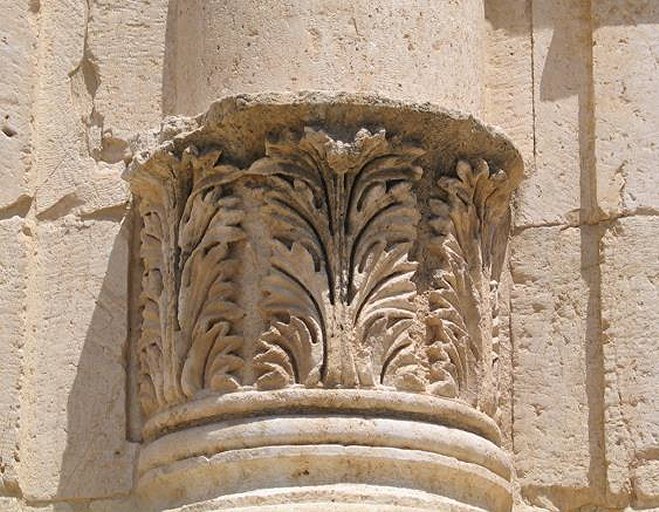
Roman acanthus detail: Jordan. |
| The earlier Saxon dating suggested by T. D.
Kendrick in 1938 was based partly on the knowledge
that the acanthus leaf did make two brief
appearances well before the 12th century and could
have been used by our accomplished sculptor for his
‘rather wild acanthus ornament’ (Nikolaus Pevsner’s
description ). Its first reappearance was the result
of Carolingian influence from the continent during
and just after the reign of Charlemagne the Great.
In the year 800 A.D. Charlemagne was created Holy
Roman Emperor, by the Pope, who resurrected the
ancient title especially for him after it had lain
dormant for many centuries. To celebrate his newly
acquired title Charlemagne built a new octagonal
chapel at his palace in Aachen in Germany, now the
Cathedral, and to emphasise his new link with Rome
he imported some ancient columns from Rome and
Ravenna to utilise in its construction. These came
complete with their Corinthian capitals that
incorporate Acanthus leaf decoration and so the
Acanthus was reintroduced into northern Europe. This
Carolingian Renaissance became a strong influence in
European culture and the acanthus leaf began to
appear in architectural detailing and in decorative
manuscript work on the continent. Charlemagne
enjoyed friendly relations with King Offa of Mercia,
whom he called his ‘brother’. Offa’s daughter
married Charlemagne’s son and they exchanged court
representatives, so inevitably there would have been
some cultural influence on the Saxon court. Although
Offa died in AD 796 that influence could have
endured into the 9th.century. It has been suggested
that Offa might have received from Charlemagne a
present of a decorated missionary’s staff after
Offa’s visits to meet the Pope in Rome, when he
sought to follow in Charlemagne’s footsteps. Even so
the Acanthus leaf does not seem to have ventured
across the English Channel to any great extent and
did not become part of the Saxon catalogue of
decorative motifs at that time. The only surviving
examples of its use in the mid-9th.century in this
country appear to be on the border of a manuscript
in the British museum; on a few Saxon coffin lids
and, according to Michael Rix, on the Wolverhampton
cross shaft, allowing, of course for other examples
that could have subsequently disappeared. |
|
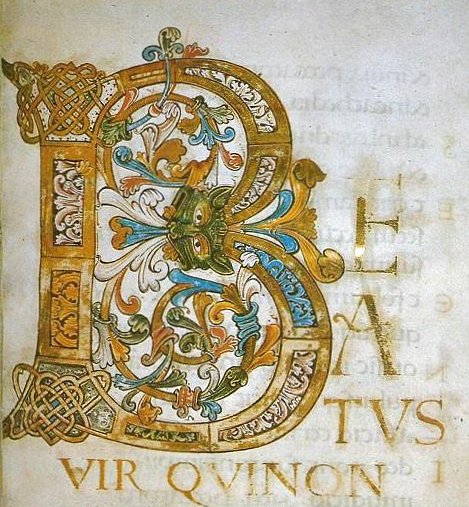
The Ramsey Psalter: late 10th.C. |
The acanthus failed to take root in post Offa Saxon
Britain and was not seen again until the middle of the
tenth century when it arrived as part of the cultural
ethos that accompanied the Benedictine Reform Period.
These reforms were introduced by continental monasteries
on the direction of King Athelstan, who was guided by
the English bishops including Aethelwold, Bishop of
Winchester. Aethelwold established artistic workshops
including manuscript illustration and sculpture where
use was made of the acanthus leaf alongside traditional
Saxon motifs. Professor Jane Hawkes believes it was this
school of design that inspired our sculptor. |
|
It is difficult for us today to
appreciate the artistic dichotomy that the carving on
the Wolverhampton column illustrates, not unlike
inserting a strip of Art Deco decoration into a Robert
Adam classical frieze. It is unlikely we will ever know
what prompted our gifted Saxon sculptor to include bands
of classical acanthus decoration within his brilliant
traditional and lively Saxon carving. One thing is
certain; the confident exuberance of his carving
displays great skill with a well-developed design
aptitude: qualities perhaps more applicable to the later
Saxon date of 950 than the earlier one of 850.
Certainly, the carving has a
confidence and quality that suggests a long period of
development, similar to some manuscript work: in
particular on the well-known Ramsey Psalter of circa
970; where acanthus scrollwork within the loops of the
ornate capital letter ‘B’ adjoins typical Saxon
interlacing.
The acanthus leaf has probably been
the most enduring architectural motif of all time; from
its traditional carved inception by the great Greek
sculptor Callymachus around 350 BC, it was never out of
use until the beginning of the 20th. Century. If you
stand by the cross shaft and look toward Barclays Bank
you will see a continuous acanthus moulding running
around the 1870’s building, 1000 years or so later than
the moulding around the cross shaft.
The Uriconium
Connection
It has been established that the
geological composition of the stone from which the
column is made is a hard, moderate to fine grained
sandstone quite unlike the sandstone in the
Wolverhampton locality which is coarser and more
friable. There is a tradition that the Wolverhampton
column is a recycled column from the Roman city of
Uriconium in Shropshire, some twenty miles to the west.
Dr. Roger White of Birmingham University, who wrote the
official guide to Uriconium, tells us that much of the
hard fine grained sandstone used in the city came from a
quarry at Hoar Edge near the Lawley Hill, eight miles to
the south of the old city. The tradition for the
column’s Roman origin is strengthened by its profile: it
has a subtle entasis (slightly curved convex outline)
synonymous with the aesthetic refinement of classical
columns generally but not seen on any other Saxon round
columns except for their short round window balusters
that are usually excessively curved. |
|
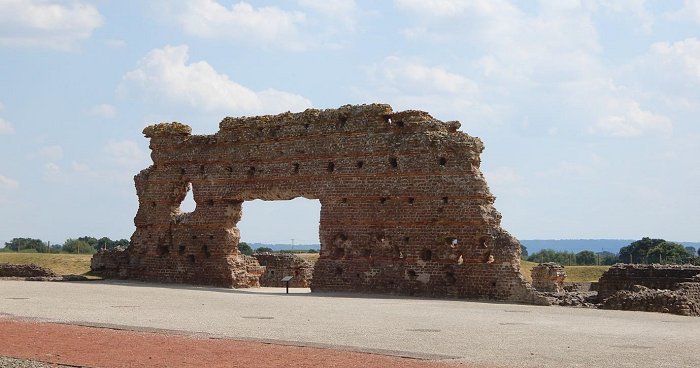
Uriconium Baths Basilica, showing
the position on the floor of lost columns. |
|
Dr. White suggests the
Wolverhampton column could have come from the Baths
Basilica adjoining Watling Street where the street
passes through the centre of the city. Part of the
external wall of the basilica, known as ‘The Old
Work’, still stands and forms the most dramatic
structure remaining in the city. He confirms that
there were 24 columns and bases inside the basilica,
and he believes some of these could still have been
upright in the middle of the ninth century. All the
columns and bases have long been removed from the
basilica by stone robbers, as were all the other
columns in the city including those at the entrance
to the Forum opposite to the basilica, but the bases
to the Forum columns still remain in a trench
excavation alongside Watling Street. Some writers
have suggested that the Wolverhampton column came
from the Forum. There is a problem with both of
these suggestions: first the remaining bases in the
forum are too small to fit our column (45 cms. and
61cms. diameter as opposed to 76 cms. diameter for
the Wolverhampton column) and the columns in the
basilica were much taller than our column but one
could have been reduced in height deliberately or
accidentally. Interestingly Dr.White reports that a
Saxon strap tag (metal belt fastener) of the 9th. or
10th. Century was found in the recently re-excavated
robber’s trench, in the south aisle of the basilica:
did a Saxon stone recycler burst his belt buckle as
he strained to move a column base!?
Another detail linking the
Wolverhampton column to the Roman remains is the
method of connecting columns to bases using the
mortice and tenon technique where a large square
dowel could have been used to connect the stone
members together. 100mm Square holes can clearly be
seen in the remaining bases of the Forum colonnade
and match precisely the 100mm. square hole in the
top of the cap on the Wolverhampton column:
suggesting a standard procedure for fixing the
column capitals and bases.
Dr. White believes the columns
in the basilica would have been of the Corinthian
order and tall enough to match the height of the
‘Old Work’. The Corinthian order was generally used
in the more important buildings. If you needed only
to support a simple roof the Tuscan order would have
been the column of choice. It was the last of the
five Roman orders to be developed and would have
been the cheapest and easiest to produce (it is
often seen today in fibre glass form flanking the
entrances to modern houses.). There are reasons to
suggest that the Wolverhampton column was of the
Tuscan order and not the Corinthian. All the Roman
orders had their specific proportions and those of
the Tuscan order seem to fit our Saxon shaft The
upper diameter should be three quarters of the lower
diameter (Wolverhampton, 22inches to 30inches; (
56cm. to 76cm.) : the height of the column should be
six times the lower diameter ( therefore our column
should be 15 feet (4.57m.) tall. It measures only 14
feet which seems to be an inconsistency, but this
could be explained by the necessity to sink the
column into a circular mortice in the huge plinth
stone. The plinth is 6 -7 feet in diameter and 1
foot 9 inches deep. A one foot (30 cms.) deep
mortice would seem to be an appropriate depth into
which to fit the column to guarantee its stability,
making it a perfect fit for the Roman Tuscan
proportions. The plinth stone weighing approximately
4 tons, appears to be of a coarser grained stone, it
is very weathered and presumably came from a local
source. It should also be noted that Corinthian
columns generally had fluted shafts: the un-sculpted
lower section of our column does not. |
|
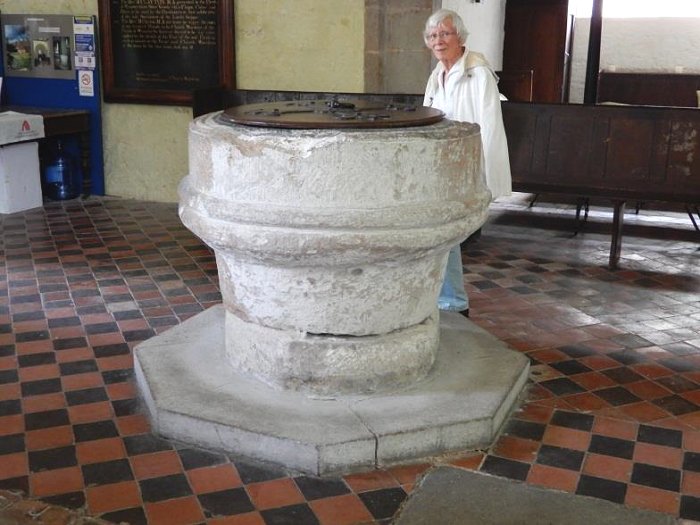
Wroxeter Church font. |
|
The column weighs approximately
3.6 metric tons so dragging it to Heanton, probably
initially along Watling Street, must have
represented a considerable physical feat as well as
a strong act of faith. It is generally agreed that
it would not have been re-carved until it had been
erected on its present site.
The Wolverhampton column
appears to be unique in one other respect, it is the
only monolithic Roman column in Britain that has
probably been standing since it was first erected
nearly one thousand nine hundred years ago, apart of
course from its brief journey to Wolverhampton.
There is another Roman Tuscan column standing in
front of York Minster, but this was dug up as
fragments from under the central tower during
underpinning work and re-erected in 1969. There are
two small columns forming gateposts at Wroxeter
church, but they were excavated in the 19th.
Century.
Of those column bases remaining
at Uriconium just one would fit the Wolverhampton
column perfectly. It lies just within the walls of
the old city located inside Wroxeter church and was
inverted and hollowed out in the Saxon period to
form the church font.
Finally, in considering the
dimensions of the cap stone on the Wolverhampton
column it is noticeable that these are what would be
expected if it was the original Tuscan capital,
allowing for the Saxon re-carving The cap has the
standard 4 inch (10 cm.) square mortice recess on
top, referred to above, now filled in with mortar.
It split at some time in the past and has been
repaired: it is tempting to speculate that the split
occurred when the crosshead separated from the
column, although it could equally be due to frost
damage.
The Problem of
Visualisation
In his study of the column,
Michael Rix was keen to provide a visual
reconstruction showing the possible original
appearance of the complete cross. He knew of the
existence of a cross head of the mid ninth century
only 34 miles away. This is the Saxon Cross head in
St. Michael’s church in the village of Cropthorne,
Worcestershire that was discovered buried in the
interior of the chancel wall when building repairs
were being carried out and proved to be relatively
undamaged. It is heavily decorated on the front and
back with animated beasts and birds in bold trails
of vegetation, not identical to those on the
Wolverhampton column but similar in character.
Strangely the edges of the arms are decorated with a
Greek key pattern. |
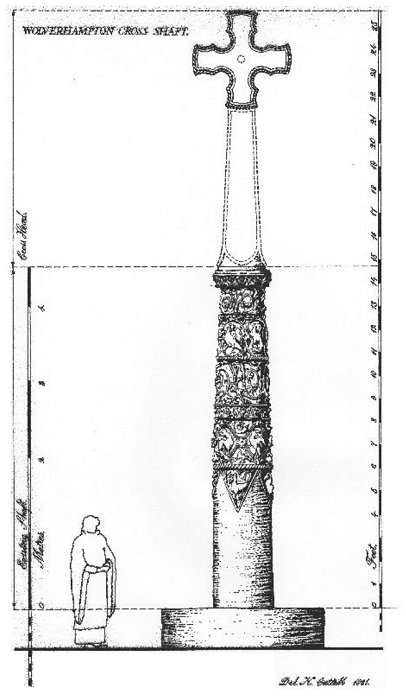 |
Mr. Rix considered that something similar to the
Cropthorne cross head was as close as we were likely
to get to the cross head that stood on the
Wolverhampton column so a drawing was prepared
showing the column with the Cropthorne cross
superimposed. This drawing was submitted to Mr. C.
A. Ralegh Radford who in Michael Rix’s words was
‘The uncrowned king of pre-conquest studies.’ at
that time. He rejected the drawing because in his
opinion the cross would have been modelled on the
missionary’s staff or rood as were other crosses of
the broader period, e.g. Leek; Ilam; Brailsford in
Derbyshire; Penrith and Beckermet in Cumberland and
many other smaller fragments in various part of the
country. All of these crosses had square tapering
shafts of varying lengths connecting the top of the
column to the cross head.
A second drawing for the Wolverhampton cross was
prepared early in 1962, showing a tapered shaft
between the column and the superimposed cross and
this became the accepted assessment of its likely
appearance.
Unfortunately, there is one major problem with
this assumption and that concerns the question of
structural integrity: by far the majority of other
examples are or once were monolithic structures
whereas the Wolverhampton cross was a composite
structure with at least three separate components.
Monolithic structures are much more resistant to
lateral stresses than a jointed structure which is
only as strong as its joints. |
|
During high winds a cross with
a long tapered shaft would have exerted excessive
leverage on the joint at the top of the main
existing column: our sculptor would have been aware
of this problem and would have been unlikely to
create a structure in an elevated position that
would be likely blow over in a severe gale.
Unfortunately despite close
examination of the column on several occasions and
photographic records being taken, no one seems to
have measured the depth of the mortice on the boss
before it was filled with a waterproof composition:
knowing its depth might have given a clue to the
height of the original superstructure.
Professor Jane Hawkes has
suggested that the initial depiction of our column,
showing the cross sitting directly on top of the
main column, is the most likely representation of
its original appearance. The revised drawing below
is similar to the first illustration, and I believe
should now be considered as its more likely original
appearance. |
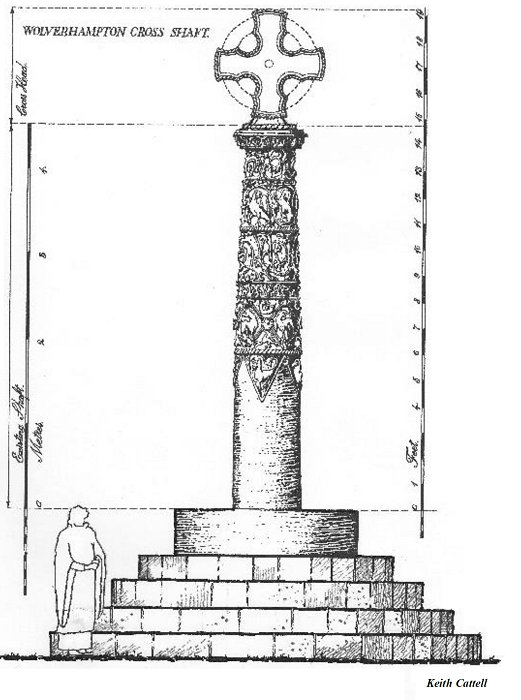 |
| When speculating on the size of the lost cross, one
key factor would be uppermost in the mind of the
sculptor, he would need to find something he could use
consisting of the same hard sandstone as the column: an
obvious choice would have been the circular column base.
We know the size of these from the Wroxeter font and a
cross carved from such a base would have been only two
or three inches shorter than the Cropthorne cross. This
of course is only speculation. The
stepped base shown in this illustration is determined by
the findings from the excavation made in 1949 under the
supervision of Michael Rix. The existing ground level
coincides approximately with the top step and indicates
how much the ground has risen as a result of centuries
of burials. The original ground level would have been
much the same as the level
of the adjacent existing pathway to the church porch.
Colour
In our multi coloured world we can
appreciate the beauty of natural stone sculpture but our
medieval ancestors who lived in a less colourful world,
valued applied colour and would use it where they could
afford to do so. Richard Bryant, a specialist in Saxon
painted sculpture who has made a close study of the
Saxon paintwork at Deerhurst Saxon Church in
Gloucestershire, is firmly of the opinion that our
column would have been painted when it was first
erected. Not quite as colourful as a Totem Pole because
the colours would have been restricted to the earth
colours, Yellow Ochre; Brick Red; White and possibly
Black. Blues; Greens; Purple; etc., would probably have
been unobtainable or too expensive.
When and where did
the Cross Head go?
Perhaps the question should be,
‘Did it fall or was it pushed’. Hundreds of crosses
throughout the British Isles have disappeared or remain
only as fragments and many of those will have been
deliberately destroyed. Mr. Michael Rix believed the
Wolverhampton cross head was probably removed during the
Puritan Commonwealth period, although he does not say as
much in his article. It is on record that the famous
nonconformist Richard Baxter of Kidderminster tried to
remove the cross head from the column in Kidderminster
during the Commonwealth period, but his ladder proved to
be too short and while he went to find a longer one a
crowd gathered and prevented him from knocking it to the
ground on his return. Such an attempt might have been
made on the Wolverhampton Cross because the rector at
St. Peter’s Church during the Commonwealth, the Rev.
John Reynolds, may well have had similar inclinations:
he was ejected in 1662 as a result of his Puritan
leanings.
There is evidence that once removed
some cross heads were treated with respect. Several
including that at Cropthorne, have been found built into
the structure of their church and others may be waiting
to be discovered, but whether this was an attempt to
preserve them or just to make use of them as building
stone is a moot point. It could be argued that if they
were treated only as a convenient source of stone they
would have been broken into more manageable pieces.
Again, at Wroxeter church in Shropshire part of a Saxon
cross shaft has been built into the external face of the
south wall of the nave in such a position that it seems
to be ‘on display’.
Not knowing the nature of the
tragedy that befell our crosshead it is not beyond the
realms of possibility that it could reappear again at
some time in the future during church building repair or
excavation works.
Future Conservation
of the Column
From time to time over the last
fifty years consideration has been given to preserving
the column before it erodes even further. A study in
1998 by Cliveden Conservation Workshops Ltd. discovered
that the stone was corroding not only externally but
also internally and will continue to do so. Proposals
have been put forward to move the column into St.
Peter’s church but much importance is placed on the fact
that it has stood in the same position for the last 1100
years or so, a view backed by English Heritage who felt
something would be lost if it was moved, even if a
replica was placed in the same position. Another
suggestion was made to place a protective cover over it,
probably the best compromise but one that would call for
a very sensitive design solution. A proposal was put
forward in 1977 by the Wolverhampton Society of
Architects to excavate around the column to expose the
original ground level and the steps as part of a general
conservation project but this was not acted upon.
A relatively simple improvement
could be made to the column’s appearance by removing the
rubble stonework around its base, that was obviously
placed there as a very crude method of preventing the
column from falling. This was carried out at some
unrecorded date, probably in the late eighteenth or
early nineteenth century.
We owe it to future Wulfrunians to
do something to preserve this Saxon Christian work of
art that is important not just for Wolverhampton but as
the West Midland Conurbation’s oldest Christian
monument.
Timescale of Events
100 AD. Approx. Roman column shaped
and carved, possibly for the interior of the Baths
Basilica at Uriconium. (Dr. Roger H. White) or the Forum
(Gerald P. Mander MA. FSA.)
850 - 950 AD. Approx. Column
brought from Uriconium to Heanton.
1649-1660. Commonwealth: danger
period for Christian iconography. Possible loss of cross
head?
1751. Shown on Isaac Taylor’s map
of Wolverhampton minus the cross head.
1877. Plaster cast taken for the
Victoria and Albert Museum.
1877. Charles Lyman comments:
profile of column not Norman but has classical entasis.
1949. Excavation around base on the
eastern side of the column, by Michael M. Rix, reveals
decayed remains of four steps.
1953. Fractured capital cramped
together.
1962. Article by Michael M. Rix for
The Royal Archaeological Institute.
1990. Inspection of the cross shaft
by Richard Marsh Conservation.
1992. An archaeological assessment
by Birmingham University Field Archaeology Unit,
including a re-excavation on the east side of the
column.
1999. The column cleaned and
repaired.
2019. Article by Professor Jane
Hawkes for the Corpus of Anglo Saxon Stone Sculpture.
Acknowledgements
This article could not have been
written without the generous contributions of the
following professional historians and I am duly indebted
to them.
Michael Rix MA.
Professor Jane Hawkes
Dr. Roger H.White.
Richard Bryant |
 |
Return to
the
previous page |
|